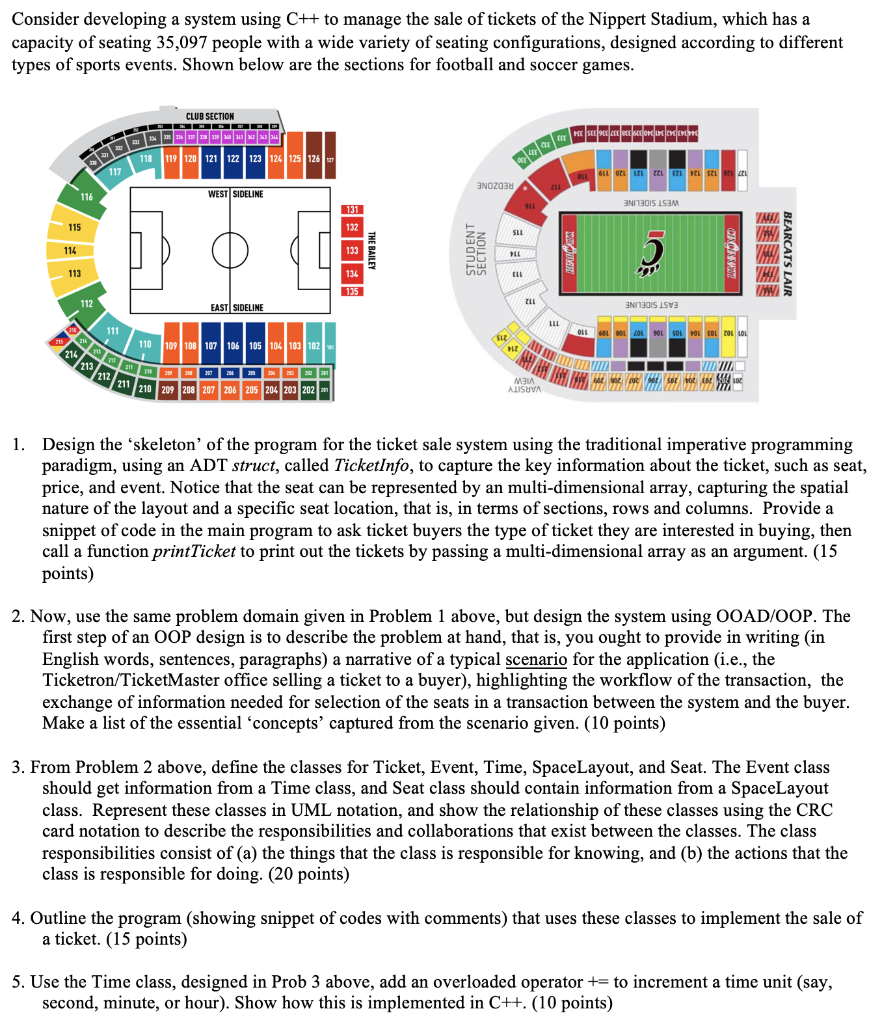PLEASE DO QUESTION 4 & 5

117 118 119 120 121 122 123 124 125 126 211 210 209 208 207 206 205 204 203 202 20 Consider developing a system using C++ to manage the sale of tickets of the Nippert Stadium, which has a capacity of seating 35,097 people with a wide variety of seating configurations, designed according to different types of sports events. Shown below are the sections for football and soccer games. CLUB SECTION SEE PECES SCOLI PER INOZU WEST SIDELINE 3N13015 153 131 115 SIL 114 STUDENT PLE 133 134 135 BEARCATS LAIR 113 ZEL 112 EAST SIDELINE aNNIS ISVS LLL 111 110 109 108 107 106 105 104 103 102 213 VIII ME ALISOVA 1. Design the 'skeleton' of the program for the ticket sale system using the traditional imperative programming paradigm, using an ADT struct, called TicketInfo, to capture the key information about the ticket, such as seat, price, and event. Notice that the seat can be represented by an multi-dimensional array, capturing the spatial nature of the layout and a specific seat location, that is, in terms of sections, rows and columns. Provide a snippet of code in the main program to ask ticket buyers the type of ticket they are interested in buying, then call a function printTicket to print out the tickets by passing a multi-dimensional array as an argument. (15 points) 2. Now, use the same problem domain given in Problem 1 above, but design the system using OOAD/OOP. The first step of an OOP design is to describe the problem at hand, that is, you ought to provide in writing (in English words, sentences, paragraphs) a narrative of a typical scenario for the application (i.e., the Ticketron/TicketMaster office selling a ticket to a buyer), highlighting the workflow of the transaction, the exchange of information needed for selection of the seats in a transaction between the system and the buyer. Make a list of the essential concepts' captured from the scenario given. (10 points) 3. From Problem 2 above, define the classes for Ticket, Event, Time, Space Layout, and Seat. The Event class should get information from a Time class, and Seat class should contain information from a Space Layout class. Represent these classes in UML notation, and show the relationship of these classes using the CRC card notation to describe the responsibilities and collaborations that exist between the classes. The class responsibilities consist of (a) the things that the class is responsible for knowing, and (b) the actions that the class is responsible for doing. (20 points) 4. Outline the program (showing snippet of codes with comments) that uses these classes to implement the sale of a ticket. (15 points) 5. Use the Time class, designed in Prob 3 above, add an overloaded operator += to increment a time unit (say, second, minute, or hour). Show how this is implemented in C++.(10 points) 117 118 119 120 121 122 123 124 125 126 211 210 209 208 207 206 205 204 203 202 20 Consider developing a system using C++ to manage the sale of tickets of the Nippert Stadium, which has a capacity of seating 35,097 people with a wide variety of seating configurations, designed according to different types of sports events. Shown below are the sections for football and soccer games. CLUB SECTION SEE PECES SCOLI PER INOZU WEST SIDELINE 3N13015 153 131 115 SIL 114 STUDENT PLE 133 134 135 BEARCATS LAIR 113 ZEL 112 EAST SIDELINE aNNIS ISVS LLL 111 110 109 108 107 106 105 104 103 102 213 VIII ME ALISOVA 1. Design the 'skeleton' of the program for the ticket sale system using the traditional imperative programming paradigm, using an ADT struct, called TicketInfo, to capture the key information about the ticket, such as seat, price, and event. Notice that the seat can be represented by an multi-dimensional array, capturing the spatial nature of the layout and a specific seat location, that is, in terms of sections, rows and columns. Provide a snippet of code in the main program to ask ticket buyers the type of ticket they are interested in buying, then call a function printTicket to print out the tickets by passing a multi-dimensional array as an argument. (15 points) 2. Now, use the same problem domain given in Problem 1 above, but design the system using OOAD/OOP. The first step of an OOP design is to describe the problem at hand, that is, you ought to provide in writing (in English words, sentences, paragraphs) a narrative of a typical scenario for the application (i.e., the Ticketron/TicketMaster office selling a ticket to a buyer), highlighting the workflow of the transaction, the exchange of information needed for selection of the seats in a transaction between the system and the buyer. Make a list of the essential concepts' captured from the scenario given. (10 points) 3. From Problem 2 above, define the classes for Ticket, Event, Time, Space Layout, and Seat. The Event class should get information from a Time class, and Seat class should contain information from a Space Layout class. Represent these classes in UML notation, and show the relationship of these classes using the CRC card notation to describe the responsibilities and collaborations that exist between the classes. The class responsibilities consist of (a) the things that the class is responsible for knowing, and (b) the actions that the class is responsible for doing. (20 points) 4. Outline the program (showing snippet of codes with comments) that uses these classes to implement the sale of a ticket. (15 points) 5. Use the Time class, designed in Prob 3 above, add an overloaded operator += to increment a time unit (say, second, minute, or hour). Show how this is implemented in C++.(10 points)







